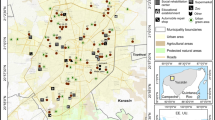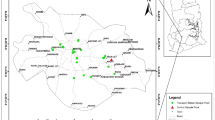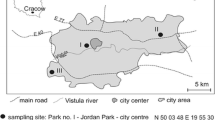Abstract
In recent decades, multiple sclerosis (MS) diseases have been significantly prevalent in some industrial areas of Iran, such as steel industrial areas in Isfahan province (central Iran). In this study, the environmental impacts of two steel mill factories in Isfahan province and their effects on the spread of MS in the region were investigated. To examine the extent of exposure, seasonal dust samples were collected from 15 sites around the two investigated factories. The annual dust deposition rate (DDR) was then determined and the concentrations of lead (Pb), cadmium (Cd), nickel (Ni), cobalt (Co), and manganese (Mn) in the dust samples were measured. Furthermore, the concentration of the mentioned elements was determined in the nail samples taken from 40 MS patients and 40 healthy people (control) living in the study region. The interpolated map extracted from the DDR values showed the highest dust deposition around the two studied steel factories, which decreases with increasing distance from them. The enrichment factor (EF) of heavy metals was the highest at the distance between the two steel factories, decreasing by moving away from them which indicate that these two steel factories are the source of investigated heavy metals in the region. The statistical analysis also revealed significant differences (P < 0.01) between the concentration of heavy metals measured in nail samples taken from MS patients and healthy people. The mean Pb concentration measured in the nail sample taken from MS patients was more than 18 times that of healthy people (93.45 and 5.02 mg/kg, respectively). These results revealed a buildup of heavy metals in the body of MS patients much more than usual, originating from the activities of two investigated steel companies in the region.





Similar content being viewed by others
Data availability
The data used in this study are available from the author upon request (nhonarjoo@khuisf.ac.ir).
References
Abdulrahman, F. I., Akan, J. C., Chellube, Z. M., & Waziri, M. (2012). Levels of heavy metals in human hair and nail samples from Maiduguri metropolis, Borno state Nigeria. World Environment, 2(4), 81–89. https://doi.org/10.5923/j.env.20120204.05
Adewumi, A. J., Laniyan, T. A., Xiao, T., Liu, Y., & Ning, Z. (2020). Exposure of children to heavy metals from artisanal gold mining in Nigeria: Evidences from bio-monitoring of hairs and nails. Acta Geochim, 39, 451–470. https://doi.org/10.1007/s11631-019-00371-9
Ahmed, I. T. & Abd-Alhameed, M. M. (2019). Spatial distribution of heavy metals in surface soil horizons surrounding Erbil Steel Company (ESC) Areas. ZANCO Journal of Pure and Applied Sciences 31(3), 32–38. https://doi.org/10.21271/ZJPAS
Amato, F., Pandolfi, M., Moreno, T., Furger, M., Pey, J., Alastuey, A., Bukowiecki, N., Prevot, A. S. H., Baltensperger, U., & Querol, X. (2011). Sources and variability of inhalable road dust particles in three European cities. Atmospheric Environment, 45, 6777–6787.
Bakri, S. F. Z., Hariri, A., Ma’arop, N. F., & Hussin, N. S. A. W. (2017). Toenail as non-invasive biomarker in metal toxicity measurement of welding fumes exposure – A review. IOP Conference Series: materials science and engineering. 165 (2017) 012019. https://doi.org/10.1088/1757-899X/165/1/012019. International Conferenceon Applied Science (ICAS2016) IOP Publishing.
Blazewicz, A., Liao, K. Y., Liao, H. H., NiziNski, P., Komsta, T., Momcilovic, B., JabBoNska-Czapla, M., Michalski, R., Prystupa, A., Sak, J. J., & Kocjan, R. (2017). Alterations of hair and nail content of selected trace elements in nonoccupationally exposed patients with chronic depression from different geographical regions. Hindawi BioMed Research International, Article ID 3178784, 10 pages. https://doi.org/10.1155/2017/3178784
Di Ciaula, A., Gentilini, P., Diella, G., Lopuzzo, M., & Ridolfi, R. (2020). Biomonitoring of metals in children living in an urban area and close to waste incinerators. International Journal Environmental Research Public Health, 17. https://doi.org/10.3390/ijerph17061919. (open access)
Etemadifar, M., & Abtahi, S. H. (2012). Multiple Sclerosis in Isfahan, Iran: Past, present and future. International Journal of Preventive Medicine, 3(5), 301–302.
Etemadifar, M., Nasr-Esfahani, A. H., Khodabandehlou, R., & Maghzi, A. H. (2007). Childhood-onset multiple sclerosis: Report of 82 patients. from Isfahan, Iran. Archives Iranian Medicine, 10(2):152 – 156.
Etemadifar, M., & Maghzi, A. H. (2011). Sharp increase in the incidence and prevalence of multiple sclerosis in Isfahan Iran. Multiple Sclerosis Journal, 17(8), 1022–1027. https://doi.org/10.1177/1352458511401460
FAO/WHO. (2015). General standards for contaminants and toxins in food and feed (CODEX STAN 193–1995). Adopted in 1995 Revised in 1997, 2006, 2008, 2009 Amended in 2010, 2012, 2013, 2014, 2015. 59 p.
Fulgenzi, A., Zanella, S. G., Mariani, M. M., Vietti, D., & Ferrero M. E. (2012). A case of multiple sclerosis improvement following removal of heavy metal intoxication: Lessons learnt from Matteo’s case. Biometals 25(3):569–76. https://doi.org/10.1007/s10534-012-9537-7
Ghazifard, A. (2013). Effect of contaminated soils with lead, zinc, and cadmium and their related dust effect on air pollution in Isfahan (Iran). International Journal Environmental Health Engineering, 2, 13.
Grobéty, B., Gieré, R., Dietze, V., & Stille, P. (2010). Airborne particles in the urban environment. Elements, 6, 229–234. https://doi.org/10.2113/gselements.6.4.229
Gutierrez-Gonzalez, E., Garcia-Esquinas, E., de Larrea-Baz, N. F., Salcedo-Bellido, I., Navas-Acienf, A., Lope, V., Gomez-Ariza, J. L., Pastor, R., Pollan, M., & Perez-Gomez, B. (2019). Toenails as biomarker of exposure to essential trace metals: A review. Environmental Research 179, 108787. https://doi.org/10.1016/j.envres.2019.108787
Iranian Meteorological Organization. (2017). Isfahan Province Daily Meteorological Data of 2012 and 2013. (Personal communication).
Jodi, L. S., & Lee, K. (2003). Soil as a source of dust and implications for human health. Advances in Agronomy 80:1–32. https://doi.org/10.1016/S0065-2113(03)80001-9
Jiaqing, Z., Wenshun, K., Min, D., Jingqiang, T., Chuxuan, L., Yizhi, C. h., & Shengguo X. (2023). A practical method for identifying key factors in the distribution and formation of heavy metal pollution at a smelting site. Journal of Environmental Sciences, 127, 552–563. Received 13 January 2022, Revised 20 June 2022, Accepted 20 June 2022, Available online 27 June 2022, Version of Record 4 July 2022. https://doi.org/10.1016/j.jes.2022.06.026Getrightsandcontent
Kamakura, M. A. (1983). Study of the characteristics of trace elements in the hair of Japanese-Reference values, the trace elements patterns for determining normal levels. Japanese Journal of Hygiene, 28, 823–838. https://doi.org/10.1265/jjh.38.823
Karimzadeh, H. R. (2002). Characteristics and genesis of soils developed on different landforms and the origin of wind-eroded sediments in eastern part of Isfahan. Ph.D. Thesis. Isfahan University of Technology, Isfahan, Iran, p. 441 (In Persian).
Khadem, M., Shahtaheri, S. J., Golbabaei, F., Rahimi Froushani, A., Ganjali, M. R., & Faridbod, F. (2015). Biological evaluation of occupational exposure to nickel and lead with the solid-phase extraction method using Chromosorb-102 resin. Scientific Journal of School of Public Health and Institute of Public Health Research, 12(4), 65–77.
Khudhur, N. S., Khudhur, S. H. M., & Ahmad, I. N. (2018). An assessment of heavy metal soil contamination in a steel factory and the surrounding area in Erbil city. Jordan Journal of Earth and Environmental Sciences, 9(1), 1–11.
Koponen, M., Gustafsson, T., Kalliomäki, K., Kalliomäki, P. L., Moilanen, M., & Pyy, L. (1980). Dusts in a steel-making plant. International Archives of Occupational Environmental Heath, 47, 35–45. https://doi.org/10.1007/BF00378326
Laniyan, T. A., & Adewumi Adeniyi, J. P. (2020). Evaluation of contamination and ecological risk of heavy metals associated with cement production in Ewekoro, southwest Nigeria. Journal of Health & Pollution, 10, No. 25 — March 2020, p 1–13. downloaded from http://meridian.allenpress.com/jhp/article-pdf/10/25/200306/2649975/2156-9614-10_25_200306.pdf by Iran, Islamic Republic of user on 09 December 2020.
Long, Z. H., Zhu, H., Bing, H., Tian, X., Wang, Zh., Wang, X., & Wu, Y. (2021). Contamination, sources and health risk of heavy metals in soil and dust from different functional areas in an industrial city of Panzhihua City, Southwest China. Journal of Hazardous Materials, 420, 126638. https://doi.org/10.1016/j.jhazmat.2021.126638
Lu, X., Wang, L., Li, L. Y., Lei, K., Huang, L., & Kang, D. (2010). Multivariate statistical analysis of heavy metals in street dust of Baoji NW China. Journal Hazardous Materials, 173, 744–749. https://doi.org/10.1016/j.jhazmat.2009.09.001
Mehra, R., & Juneja, M. (2005). Fingernails as biological indices of metal exposure. Journal of Biosciences, 30, 253–257. https://doi.org/10.1007/BF02703706
Menendez, I., Diaz-Hernandez, J. L., Mangas, J., Alonso, I., & Sanchez-Soto, P. J. (2007). Airborne dust accumulation and soil development in the north-east sector of Gran Canaria (Canary Islands, Spain). Journal of Arid Environments, 71, 57–81. https://doi.org/10.1016/j.jaridenv.2007.03.011
Moradi, A., Honarjoo, N., Najafi, P., & Fallah, J. (2016a). A human health risk assessment of soil and crops contaminated by heavy metals in industrial regions, central Iran. Human and Ecological Risk Assessment, 22(1):153–167. https://doi.org/10.1080/10807039.2015.1056293
Moradi, A., Honarjoo, N., Najafi, P., & Fallah, J. (2016b). Bio- accumulation of some heavy metals in blood serum of residents in Isfahan and Shiraz, Iran. Environmental Monitoring and Assessment, 188(5):260–269. https://doi.org/10.1007/s10661-016-5217-3
Norouzi, S., Khademi, H., Ayoubi, S. H., Faz Cano, A., & Acosta, J. A. (2017). Seasonal and spatial variations in dust deposition rate and concentrations of dust-borne trace metals, a case study from Isfahan, central Iran. Atmospheric Pollution Research, 8, 686–699. https://doi.org/10.1016/j.apr.2016.12.015
Omidi Khaniabadi, Y., Daryanoosh, S. M., Hopke, P. K., Ferrante, M., De Marco, A., Sicard, P., Conti, G. O., Goudarzi, G. R., Basiri, H., Mohammadi, M. J., & Keishams, F. (2017). Acute myocardial infarction and COPD attributed to ambient SO2 in Iran. Environmental Research, 156, 683–687. https://doi.org/10.1016/j.envres.2017.04.028
Pallant, J. (2011). SPSS survival manual: a step by step guide to data analysis using SPSS for Windows. fourth edition. Allen and Unwin Co. Crows Nest NSW 2065, Australia, 359 p.
Parizanganeh, A., Zamani, A., Bijnavand, V., & Taghilou B. (2014). Human nail usage as a Bio-indicator in contamination monitoring of heavy metals in Dizajabaad, Zanjan Province-Iran. Journal of Environmental Health Science & Engineering 12:147. https://doi.org/10.1186/s40201-014-0147-x
Qayyum, M. A., & Shah, M. H. (2014). Comparative assessment of selected metals in the scalp hair and nails of lung cancer patients and controls. Biological Trace Element Research, 158, 305e322.
Risser, J. A., & Baker, D. E. (1990). Testing soils for toxic metals. In: Westerman, R.L. (Ed.), Soil testing and plant analysis. Soil Science Society of America, Inc., Madison. WI, pp. 275–298. https://doi.org/10.2136/sssabookser3.3ed.c11
Schiffer, R. B. M. C., Dermott, M. P., & Copiey, C. A. (2002). A multiple sclerosis cluster associated with a small north –central Illinois community. Archives of Environmental Health, 57(4), 389–395. https://doi.org/10.1080/00039890109604473
Shi, G. T., Chen, Z. L., Bi, C. J., Wang, L., Teng, J., Li, Y. S., & Xu, S. Y. (2011). A comparative study of health risk of potentially toxic metals in urban and suburban road dust in the most populated city of China. Atmospheric Environment, 45, 764–771. https://doi.org/10.1016/j.atmosenv.2010.08.039
Soleimani, M., Amini, N., Sadeghian, B., Wang, D., & Fang, F. (2018). Heavy metals and their source identification in particulate matter (PM2.5) in Isfahan City Iran. Journal of Environmental Sciences, 72, 166–175.
Soltani, S., Keshavarzi, B., Moore, F., Tavakol, T., Lahijanzadeh, A. R., Jaafarzadeh, N., & Kermani, M. (2015). Ecological and human health hazards of heavy metals and polycyclic aromatic hydrocarbons (PAHs) in road dust of Isfahan metropolis. Iran. Science of the Total Environment, 505, 712–723. https://doi.org/10.1016/j.scitotenv.2014.09.097
Tabachnick, T. G., & Fidell, L. S. (2013). Using multivariate statistics (6th ed., p. 983). Pearson Education Inc.
Yongming, H., Peixuan, D., Junji, C., & Posmentier, E. S. (2006). Multivariate analysis of heavy metal contamination in urban dusts of Xi’an, Central China. Science of the Total Environment, 355, 76–86. https://doi.org/10.1016/j.scitotenv.2005.02.026
Zhang, C., Qiao, Q., Appel, E., & Huang, B. (2012). Discriminating sources of anthropogenic trace metals in urban street dusts using magnetic and chemical methods. Journal of Geochemical Exploration, 119–120, 60–75. https://doi.org/10.1016/j.gexplo.2012.06.014
Ziyaee, A., Karimi, A., Hirmas, D. R., Kehl, M., Lakzian, A., Khademi, H., & Mechem, D. B. (2018). Spatial and temporal variations of airborne dust fallout in Khorasan Razavi Province, northeastern Iran. Geoderma, 326, 42–55. https://doi.org/10.1016/j.geoderma.2018.04.010
Acknowledgements
The authors thank the vice chancellor for research of the Islamic Azad University of Isfahan (Khorasgan) for providing the facilities for this research.
Author information
Authors and Affiliations
Contributions
All authors contributed to the study conception and design of the research. The part related to the sampling of MS patients and related analyzes were carried out under the supervision of Dr. Besalat pour. Material preparation, data collection and analysis were done by Dr. Moradi. Map production, and writing the initial version of the manuscript were done by Dr. Honarjoo. All authors have read the manuscript, added comments and approved the final manuscript.
Corresponding author
Ethics declarations
Competing interests
The authors declare no competing interests.
Ethics approval
Dr. Masoud Etemadifar, one of the authors of this article, was the supervisor of the MS Department of Al-Zahra Hospital in Isfahan. He compiled a questionnaire and gave it to 40 MS patients who were treated under his supervision, to collect information from them. This part of the research was conducted under the supervision of the head of the MS department of Al-Zahra Hospital, and following his research.
Ethical responsibilities of authors
All authors have read, understood, and have complied as applicable with the statement on “Ethical responsibilities of authors” as found in the Instructions for authors and are aware that with minor exceptions, no changes can be made to authorship once the paper is submitted.
Consent to participate
Informed consent was obtained from all individual participants included in the study.
Consent to publish
The participant has consented to the submission of the case report to the journal.
Additional information
Publisher's Note
Springer Nature remains neutral with regard to jurisdictional claims in published maps and institutional affiliations.
Rights and permissions
Springer Nature or its licensor (e.g. a society or other partner) holds exclusive rights to this article under a publishing agreement with the author(s) or other rightsholder(s); author self-archiving of the accepted manuscript version of this article is solely governed by the terms of such publishing agreement and applicable law.
About this article
Cite this article
Moradi, A., Honarjoo, N., Besalatpour, A.A. et al. Human exposure to dust and heavy metals in industrial regions and its relationship with the prevalence of multiple sclerosis disease. Environ Monit Assess 195, 471 (2023). https://doi.org/10.1007/s10661-023-11017-y
Received:
Accepted:
Published:
DOI: https://doi.org/10.1007/s10661-023-11017-y




